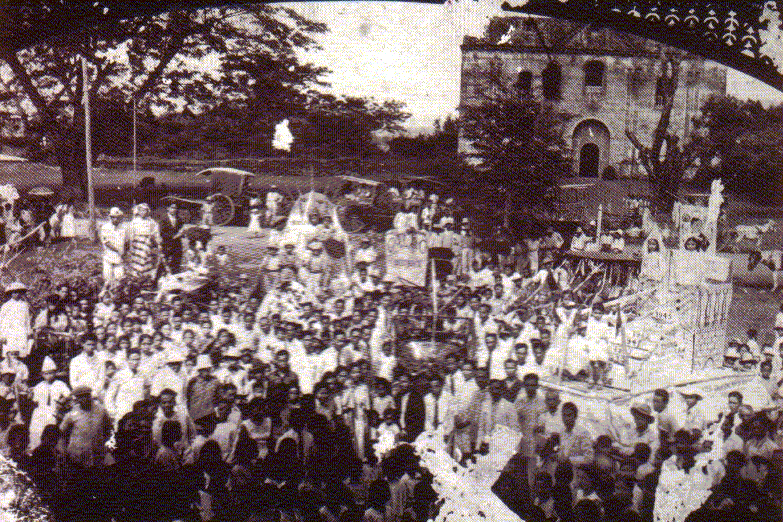
HISTORICAL BACKGROUND
Brief History
The origin of Santiago can be traced out to the first native settlement near the bank (now the area between Brgy. Ambalatungan and Brgy. Buenavista) of the Carig River (now Diadi River) from which its name was derived. The first inhabitants were the Ibanags and Gaddangs.

Before the Spanish evangelizers gained foothold on the frontiers of this place, it was alredy known as "Carig". Carig means "tall and straight trees". These were abundant in the area in those early days. During the Spanish Era, it was founded as a political pueblo on May 4, 1743 with Santiago Apostol as Patron Saint. Then in 1746, it was transferred to the site of Patul. It was called Carig, Santiago de Carig, Pueblo de Carig of Santiago Apostol de Carig. On October 12, 1903, during the American Occupation, Carig and Cordon were combined with the Municipality of Echague. It was part of the strategic move by the Americans to reduce the number of municipalities. From 1903 to 1909, Carig had been annexed to Echague. Until on January 01, 1910, during the municipal reorganization, the Americans issued Executive Order No. 02 making Carig a municipality but was baptized with a new name SANTIAGO. Note that the Apostol de Carig was deleted from its original name Santiago Apostol de Carig. It was Kapitan Vicente Carreon, who was then the Municipal President of the town that time, who changed the name Carig into Santiago, in honor to St. James the Apostle, the Patron Saint of the town
Santiago remained as a municipality for 84 years. Until on May 5, 1994, by virtue of RA 7720, the Municiplity was converted into an independent component Santiago CIty.
The Road to Cityhood
Cityhood for the town of Santiago is an enduring popular
progress, which Mayor Jose "Pempe" C. Miranda turned
out of the earlier dream of his predecessors.
The march to cityhood has been long and tedious, yet dramatically
shows that when people unite and work together for a common
desire, they can achieve monumental results. During his second
term in office, Mayor "Pempe" Miranda took with
characteristic boldness the preparatory steps towards the
realization of cityhood for the town of his birth.
In 1992, he issued Executive Order No. 92-05, which created and
tasked an ad hoc committee to conduct a thorough study and submit
recommendations on the conversion of Santiago into a city. The
committee was headed by MLGOO Carlos L. Hernal. It was at once
found out that the town's population was not yet large enough to
qualify for cityhood. However, the acute legalistic mind of
Fiscal Valentin Pelayo saw the possibility of cityhood as
contained in the Local Government Code which provides that a
municipality may be converted into a city as long as one of the
two requirements - number of population and volume of revenue -
is met.
Being now sure that Santiago had the qualification for cityhood,
Mayor Miranda right away geared for an intelligent attempt at
earning urban distinction for Santiago. On February 15, 1993, he
signed Executive Order No. 93-03, which created a joint
Executive-Legislative Committee on Cityhood. The fired up Mayor
himself headed the committee whose members included all members
of the Sangguniang Bayan, all the heads of municipal government
offices, and Fiscal Pelayo.
On February 19, 1993, Santiago municipal government officials
visited and toured the cities of San Jose and Cabanatuan in Nueva
Ecija, San Carlos in Pangasinan, and Angeles in Pampanga.
Immediately afterwards, consultations and dialogues regarding
cityhood were conducted to get the people's pulse.
On March 04, 1993, a significant step towards cityhood had been
taken when the Sangguniang Bayan approved Executive Resolution
No. 93-29, which was subsequently endorsed by the Sangguniang
Panlalawigan of Isabela under the leadership of Gov. Benjamin Dy
and Vice Gov. Manuel Binag. In this resolution, authored by all
of the members of the Sangguniang Bayan, Rep. Antonio Abaya was
asked to sponsor a bill providing for the conversion of the
Municipality of Santiago into a city. The Honorable Congressman
obliged and House Bill No. 8817 was filed at the Lower House
under his sponsorship and those of Reps. Albano, Respicio, and
Dy, Jr. On November 25, 1993, the bill was discussed extensively
in a public hearing conducted by the House of Representatives
Committee on Local Government, chaired by Rep. Ciriaco Alfelor of
Camarines Sur.
On December 17, 1993, the bill converting Santiago into an
independent component city was approved by the Lower House.
On February 23, 1994, Senate Bill No. 1243, which had been
sponsored jointly by Sens. Roco and Romulo, the Senate majority
Floor Leader, was presented for public hearing. It was approved
on March 14, 1994 after another public hearing conducted by the
Senate Committee on Local Government, chaired by Sen. Sotto III.
On May 05, 1994, a historic event took place in Malacaņang
Palace, Manila, upon the signing of Republic Act No. 7720 by His
Excellency, President Fidel V. Ramos, creating the town of
Santiago as an independent component city - the first in Region
2.
On July 06, 1994, a plebiscite ratified R.A. 7720 with positive response to cityhood.
